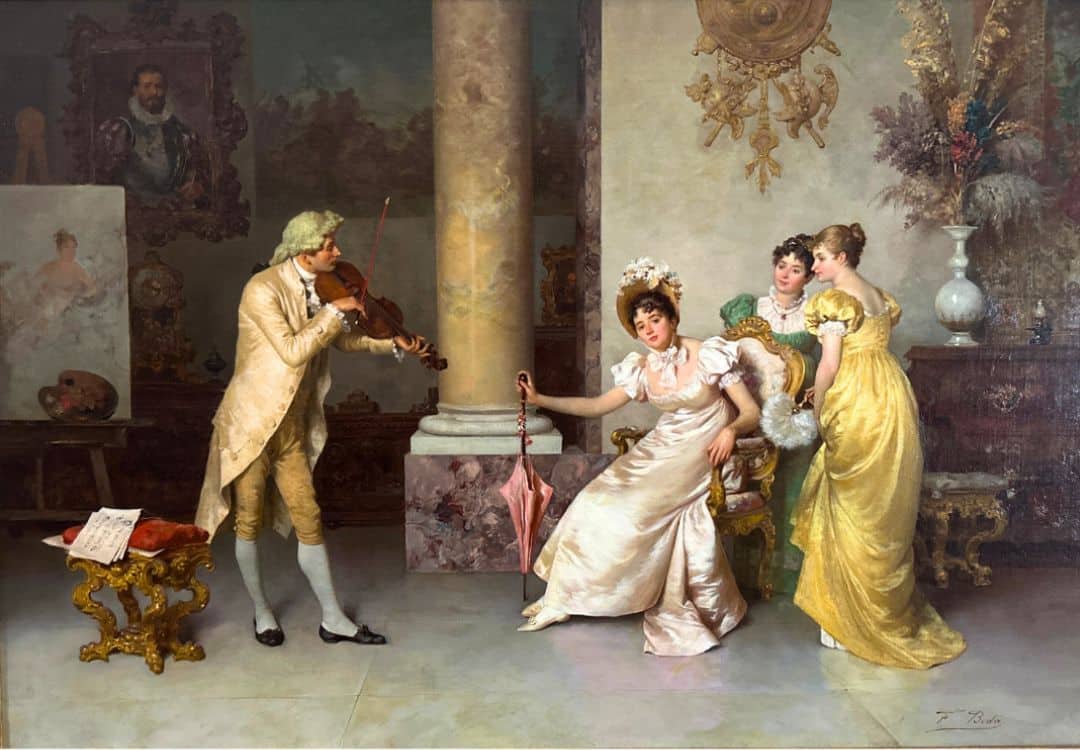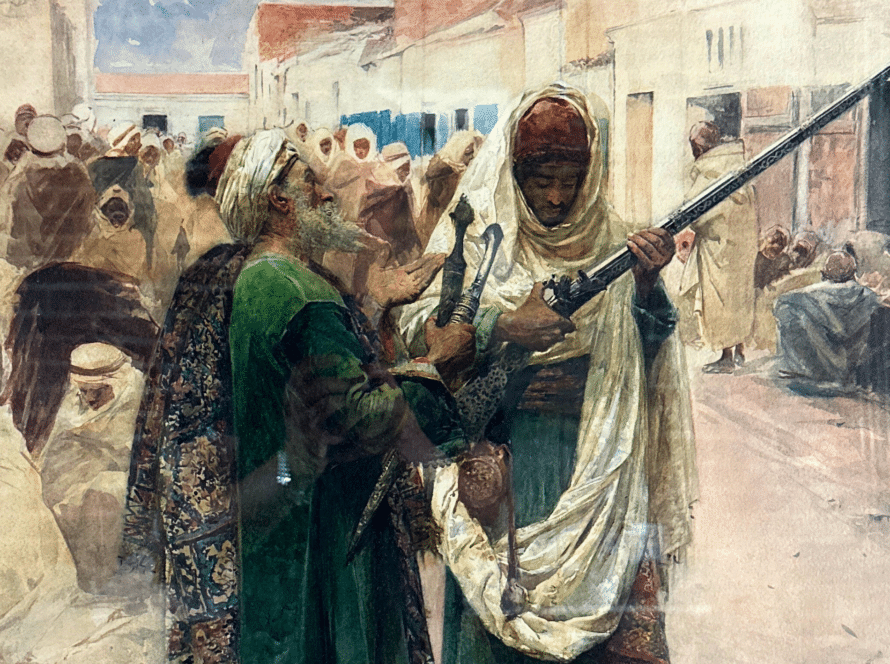Intro
In the world of art, there are many treasures to be discovered and appreciated. However, with the rise of mass production and counterfeit pieces, it has become increasingly difficult to distinguish between genuine antique artwork and cheap imitations. This is especially true for Orientalist paintings, a popular genre of 19th century art that depicts scenes and subjects from the Middle East and North Africa. In this blog post, we will provide a comprehensive guide to help you separate the wheat from the chaff and identify authentic Orientalist paintings from the 19th century.
The Appeal of Antique Art: Why it’s Worth the Search
Antique Fine Art holds a certain allure that cannot be replicated by modern pieces. There is a sense of history, craftsmanship, and cultural significance that comes with owning a piece of the past. This is especially true for Orientalist Artwork from the 19th century, a genre that captures the beauty and mystique of the Middle East and North Africa.
Vintage Orientalism offers a glimpse into a different time, allowing us to travel through art and explore the landscapes, customs, and traditions of distant lands. These Orientalist Masterpieces evoke a sense of nostalgia and curiosity, sparking our imagination and transporting us to another era.
Investing in 1800s Fine Art not only grants us a unique piece for our collection, but it also allows us to connect with history and culture in a profound way. The value of these Orientalist Pieces extends far beyond their monetary worth, as they offer a tangible link to a specific moment in time, a story waiting to be uncovered.
Historical Orientalist Paintings can also be a source of inspiration and education. By immersing ourselves in the art of the past, we gain insights into different cultures, broaden our perspective, and foster a deeper appreciation for the diverse world we live in.
Distinguishing Between Real and Fake:
Understanding Antique Art Authenticity
When it comes to antique artwork, distinguishing between the real deal and a fake can be a daunting task. However, understanding the authenticity of antique art is crucial in order to make informed purchases and build a valuable collection. Here are some key factors to consider when distinguishing between real and fake antique artwork:
- Quality of Craftsmanship: Genuine antique artwork from the 19th century often showcases exceptional craftsmanship. Pay close attention to the brushstrokes, fine details, and overall technique used in the piece. Authentic artwork will exhibit a level of skill and precision that is difficult to replicate.
- Materials and Aging: Antique artwork should show signs of aging, such as discoloration, crackling, and yellowing. Additionally, consider the materials used. For example, oil paintings from the 19th century would typically be done on canvas, while modern reproductions may use different materials.
- Signature and Artist Identification:
Research the artist and their signature style. Genuine antique artwork will often have a well-known artist associated with it, and their signature should match their known style and handwriting. Be cautious of any artwork with vague or inconsistent artist signatures.
- Historical Accuracy: Authentic antique artwork should reflect the historical period it depicts. Research the subject matter and compare it to accurate historical records to ensure that the details and scenes are portrayed correctly.
- Provenance: The artwork’s provenance, or ownership history, can provide valuable clues about its authenticity. Look for documentation that traces the artwork back to its original source, preferably through reputable art dealers or galleries.
Key Traits to Look for in Genuine Antique Artwork
When it comes to identifying genuine antique artwork, there are key traits that can help you distinguish between the real deal and a fake. These traits not only add to the authenticity of the piece but also contribute to its overall value and significance. Here are some key traits to look for when examining antique artwork:
- Age and Patina: Genuine antique artwork will exhibit signs of aging, such as discoloration, crackling, and yellowing. These signs of wear and tear add to the charm and authenticity of the piece. Additionally, examine the patina – the natural sheen or luster that develops over time – as it can provide clues about the age and authenticity of the artwork.
- Brushstrokes and Technique: Pay close attention to the brushstrokes and overall technique used in the artwork. Genuine antique pieces often showcase exceptional craftsmanship, with fine details and precise brushwork. Look for a sense of depth and dimensionality in the painting, as this is often indicative of a genuine artwork from the 19th century.
- Artist’s Style: Familiarize yourself with the artist’s style and signature. Genuine antique artwork will often have a well-known artist associated with it, and their signature should match their known style and handwriting. Research the artist’s body of work to understand their unique characteristics and artistic choices.
- Subject Matter and Historical Accuracy: Consider the subject matter depicted in the artwork and compare it to accurate historical records. Authentic antique artwork should reflect the historical period it represents, with accurate details and scenes. Research the subject matter and consult historical references to ensure the accuracy of the artwork.
- Materials Used: Antique artwork from the 19th century would typically be done on canvas using oil paint. Pay attention to the materials used in the artwork, as modern reproductions may use different materials. Genuine antique pieces will exhibit the appropriate materials for the time period.
Evaluating Provenance:
Unveiling an Artwork’s Past
Evaluating the provenance of an artwork is like peeling back the layers of history to reveal its fascinating past. Provenance refers to the ownership history of an artwork, and it can provide valuable clues about its authenticity and journey over time. When evaluating provenance, there are several factors to consider.
First, examine any documentation that accompanies the artwork. Look for invoices, receipts, or letters that trace the artwork back to its original source. Reputable art dealers and galleries often keep detailed records of an artwork’s ownership, which can enhance its provenance.
Next, consider the reputation of previous owners. Were they well-known collectors or institutions with a passion for art? Their endorsement can add value and credibility to the artwork’s provenance.
It is also important to scrutinize any exhibition or auction history. Has the artwork been displayed in reputable museums or galleries? Has it appeared in important auctions or collections? This information can offer insights into the artwork’s desirability and cultural significance.
Finally, consult art databases, catalogues raisonnés, or scholarly publications to see if the artwork has been researched and documented. If it has been included in respected publications or referenced by experts in the field, it lends further credibility to its provenance.
Harnessing Professional Help:
Seeking Art Experts, Historians, and Appraisers
Finding genuine antique artwork can be a challenging endeavor, especially if you’re not familiar with the intricacies of the art world. That’s where art experts, historians, and appraisers come in. These professionals possess the knowledge and expertise to help you navigate the vast and often complex world of antique art.
Art experts can provide invaluable guidance when it comes to identifying genuine antique artwork. They have extensive knowledge of art history, styles, and techniques, allowing them to accurately assess the authenticity and value of a piece. They can also help you identify the artist and provide insights into their body of work, aiding in your quest for genuine artwork.
Historians specialize in researching and contextualizing art. They can help you understand the historical significance of a piece, providing valuable insights into the cultural and artistic movements of the time. Historians can also shed light on the subject matter depicted in the artwork, ensuring its accuracy and authenticity.
Appraisers play a crucial role in determining the value of antique artwork. They assess factors such as provenance, condition, rarity, and demand to provide an accurate estimate of an artwork’s worth. Appraisers can also offer advice on selling or insuring your antique art collection, ensuring you make informed decisions regarding your investment.
When seeking professional help, it’s important to choose individuals who have a proven track record and expertise in the specific genre or era of art you’re interested in. Look for reputable art dealers, galleries, or auction houses that employ knowledgeable experts. Don’t be afraid to ask for references or inquire about their qualifications.
Discover Museum-Quality Orientalism Paintings at Worth Antiques
If you are in search of real museum-quality antique Orientalism paintings, Worth Antiques is your destination. With over 60 years of expertise in the market and a proud membership in the Jacksonville Chamber, Worth Antiques is synonymous with excellence and trust. consider exploring their collection at Worth Antiques Fine Art Collection for an exquisite addition to your collection.
Exceptional Collection:
At Worth Antiques, we take pride in curating an exceptional collection of fine art and collectibles. Our selection includes works from renowned artists and makers who have left an indelible mark on the fine and decorative arts. With a diverse range of pieces spanning different styles, periods, and mediums, we offer something unique and captivating for every discerning collector.
Unparalleled Expertise:
Our team consists of knowledgeable experts with a deep passion for art and collectibles. We have a keen eye for quality and craftsmanship, ensuring that each item in our collection meets our rigorous standards. Whether you are seeking advice on a specific piece, assistance in building your collection, or information about an artist, our experts are here to provide personalized guidance and share their wealth of knowledge.
Trust and Authenticity:
Trust is paramount in the art world, and we prioritize the authenticity of our collection. Every item at Worth Antiques undergoes thorough research and scrutiny to ensure its genuineness. We work with reputable sources, employ expert appraisers, and offer third-party authentication services to guarantee the authenticity of our pieces. When you choose Worth Antiques, you can have confidence in the provenance and quality of your acquisitions.
Personalized Service:
We believe in providing a personalized and attentive experience to our customers. From assisting you in finding the perfect piece to addressing your inquiries and needs, we are dedicated to delivering exceptional customer service. Our team takes the time to understand your preferences, guiding you through our collection and helping you make informed decisions based on your tastes and interests.
Transparency and Integrity:
At Worth Antiques, we value transparency and operate with the utmost integrity. We provide accurate and detailed descriptions of each item, accompanied by high-resolution images that capture the essence of the piece. Our pricing is fair and competitive, reflecting the value and quality of our collection. We are committed to fostering trust and long-term relationships with our customers by maintaining transparency in all our interactions.
Worldwide Reach:
While based in Jacksonville, Florida, our reach extends globally. We source exceptional pieces from around the world, discovering hidden treasures and placing them in international collections. Whether you are a local collector or located halfway across the globe, you can access our remarkable collection and experience the joy of owning extraordinary art and collectibles.
Commitment to Customer Satisfaction:
Customer satisfaction is at the core of our philosophy. We strive to exceed your expectations by providing a seamless buying experience, prompt shipping, and secure packaging. Your happiness and enjoyment of your purchase are our top priorities, and we go the extra mile to ensure that you are delighted with your acquisition.
Visit Worth Antiques Fine Art Collection to explore our exquisite offerings and add a touch of timeless beauty to your collection.


